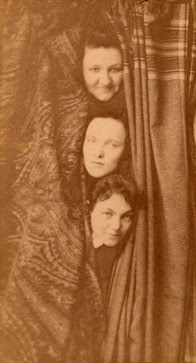translation of #MaryFrancesWinston's paper by @ulaulaman from German #mathematics #Riemann
In the few last days I have search for more links about Mary Frances Winston, and I find the paper written by Mary when she was at Göttingen. So I try to translate(1) it using Google. I hope that this version is enough clear.
Riemann defined in its basic treatise the related $P$-functions first of all such as, whose exponents differ by integers, while the exponents are subject only to the condition that their sum is equal to 1:
\[\alpha' + \alpha'' + \beta' + \beta'' + \gamma' + \gamma'' = 1 \qquad (1)\]
and that none of the differences
\[\pm (\alpha' - \alpha''), \; \pm (\beta' - \beta''), \; \pm (\gamma' - \gamma'')\]
should be an integer. Meanwhile, the analytical definition provided herein is not the essence of the relationship. Rather all of the following developments about Riemann's related funcrions rest thereon, if only
related functions should have the same monodromy. Now, Prof. Klein in his lectures about the hypergeometric function in the winter 1893-94, essentially noted that the latter is generally a result of the aforementioned analytical definition and that a special case exists, which is an exception. It is those exponents' system in which there exists the relation:
\[\pm (\alpha' - \alpha'') \pm (\beta' - \beta'') \pm (\gamma' - \gamma'') = 2k + 1 \qquad (2)\]
where $k$ is an arbitrary integer. Here are the P-functions:
\[P \begin{pmatrix}
0 & \infty & 1 & \\
\alpha' + a' & \beta' + b' & \gamma' + c' & x \\
\alpha'' + a'' & \beta''+ b'' & \gamma'' + c'' &
\end{pmatrix} \qquad (3)\]
(where $a'$, $a''$, $b'$, $b''$, $c'$, $c''$ are integers of zero-sum) divide into two separate bands such that only the P-functions of the individual band are related to each other, i.e. have the same monodromy.
I was busy trying to find the analytical features of these two bands, and so the Riemann's initial analytical definition of the complete set, that fits all cases included in the Riemann treatise. My result is this:
It finds a relation instead of (2), so the left side of (1) breaks down in two integer triplets
\[\alpha' + \beta' + \gamma' \qquad \text{and} \qquad \alpha'' + \beta'' + \gamma''\]
On of such triplet (due to (1)) is necessarily positive, the other null or negative. We assume the definite expression for the triplet $(\alpha' + \beta' + \gamma')$ to be positive.
The function (3) is given by the $P$-function if and only if the corresponding triplet
\[\alpha' + a' + \beta' + b' + \gamma' + c'\]
is also positive.
The proof is very simple. It is sufficient to establish the singular points $0$, $\infty$, $1$ corresponding fundamental branches of the P-function in the form of hypergeometric series and then to make the comparison. For example, for $x = 0$we have:
\[P^{(\alpha')} = x^{\alpha'} \cdot (1-x)^{\gamma'} \cdot F (\alpha' + \beta' + \gamma', \alpha' + \beta'' + \gamma', 1 + \alpha' - \alpha'', x)\]
\[P^{(\alpha'')} = x^{\alpha''} \cdot (1-x)^{\gamma''} \cdot F (\alpha'' + \beta' + \gamma'', \alpha'' + \beta'' + \gamma'', 1 + \alpha'' - \alpha', x)\]
and here we see immediately that the one or other of the $F$-series breaks that occur (and therefore represents a rational integral function of $x$), according as
\[(\alpha' + \beta' + \gamma') \qquad \text{or} \qquad (\alpha'' + \beta'' + \gamma'')\]
It is a null or negative integer. This is the essence. Here I don't discuss further details.
Winston, F.M. (1895). Eine Bemerkung zur Theorie der hypergeometrischen Function, Mathematische Annalen, 46 (1) 160. DOI: 10.1007/BF02096208 (
Göttinger Digitalisierungszentrum |
Academic Search)
(1)
It seems that an english version of the paper exists, but I cannot find it.



